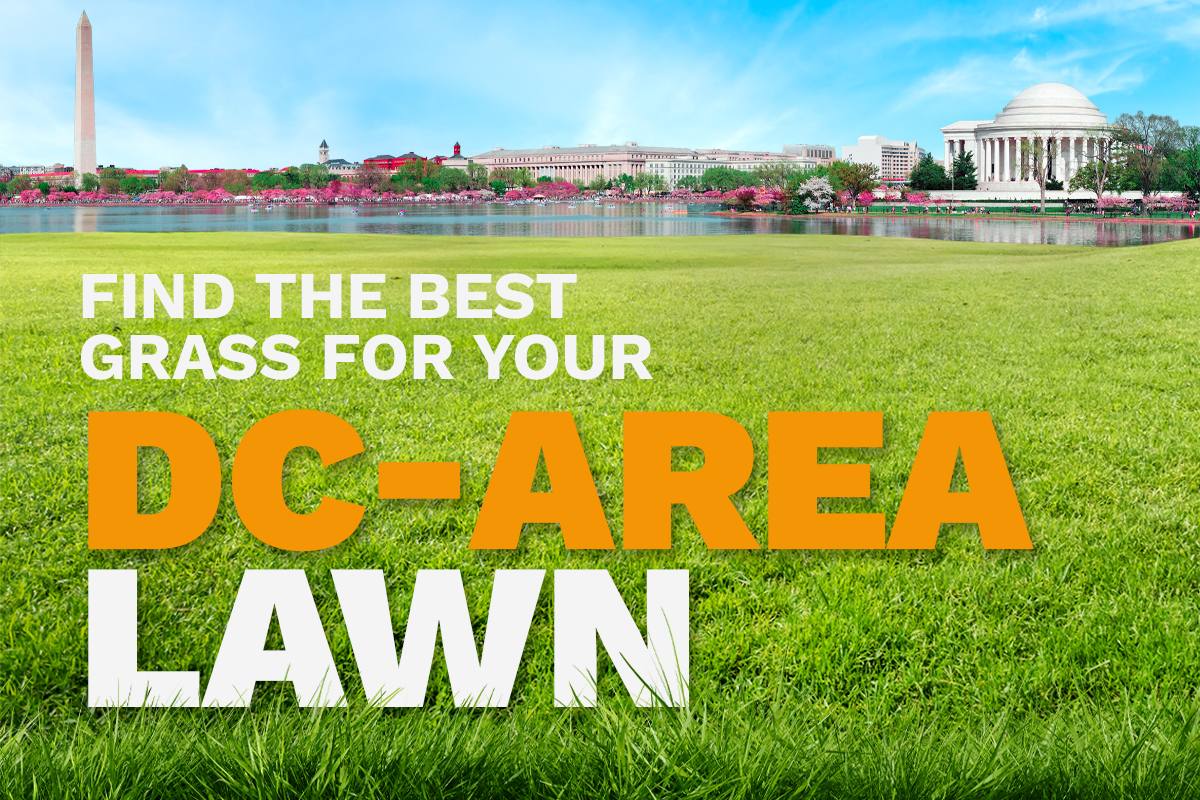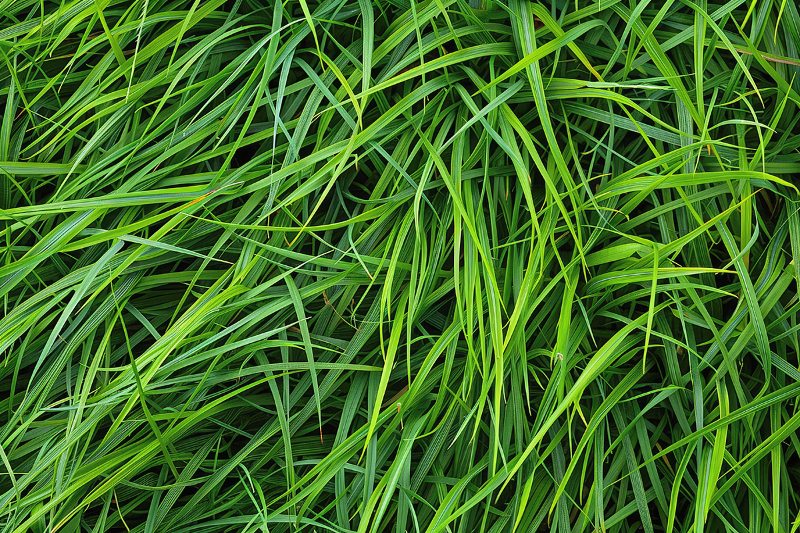
The best grass types for the Washington, D.C. area can handle the hot summers and cold winters of our tricky “transition zone” climate. Tall fescue and Kentucky bluegrass are popular choices, but fine-leaf fescues and perennial ryegrass are underrated options that also work.
Both cool-season and warm-season grasses can do well in the D.C. area, but it’s generally easier to establish your lawn with cool-season grass types like these.
Take the quiz below and see what our experts think is the best fit for your lawn, and read more about the best grass types for Washington, D.C.
What Grass is Best For You?

Depending on how much sun it gets, how much foot traffic it has to endure, and how much work you want to put into it, your ideal turf may not be the same as your neighbors’. Plug in your preferences below, and we’ll tell you the grass type you should consider.
1. Tall Fescue

Tall fescue is a very well-adapted turfgrass for D.C. lawns, with over 100 different cultivars. It has the deepest root system of all cool-season grasses, making it extra drought-resistant – in hot summer climates like D.C., it can pull extra water from deeper in the soil.
Tall fescue doesn’t generate much thatch, so it won’t suffocate your lawn. It’s resistant to dollar spot and chinch bugs, though it may be vulnerable to brown patch. Overseeding will help your tall fescue bounce back from disease more easily, and it’s also especially important because tall fescue is a bunch-type grass, so it won’t fill in gaps on its own.
Note: The best time to overseed a tall fescue lawn is in the fall, generally before early October. Aerating before overseeding will help the seeds permeate the soil.
DC Pro Tip (from Jonathan Villatoro of L&P Enterprise): Use pre-emergent and post-emergent [herbicides] and fertilizer and water at least 2-3 times a week.
- Foot Traffic Tolerance: Moderate
- Mowing Height: 2-4 inches or taller
- Potential for Disease: Moderate; resistant to dollar spot, vulnerable to brown patch
Read More:
- Tall Fescue Lawn Maintenance Guide
- How to Overseed in the Fall with Fescue
- How and When to Fertilize Fescue
2. Kentucky Bluegrass

Kentucky bluegrass is a very popular grass type that creates a beautiful emerald-green lawn with a soft texture. It requires a little extra maintenance to shine, and can be vulnerable to diseases and pests, but has the best cold tolerance of all cool-season grass types.
Bluegrass is a good choice for D.C. area lawns because it goes dormant in drought instead of dying off, making it well-suited to the transition zone. When managed properly, Kentucky bluegrass will bounce back better from disease, especially if you opt for newer, hardier cultivars or hybrids.
Note: Kentucky bluegrass’ resistance to disease and tolerance of shade and foot traffic vary widely by cultivar. Make sure you’re getting the type that’s best for your needs!
DC Pro Tip (from Mark Burke in Manassas): Kentucky 31 seems to be the most common type. Watering regularly and seeding any bare spots in the yard will help any yard look better.
- Foot Traffic Tolerance: Low
- Mowing Height: 2-3 inches
- Potential for Disease: Moderate to high
Read More:
3. Fine-Leaf Fescues

Fine-leaf fescues are an underused grass type, but they’re well-adapted to Northern Virginia’s Piedmont region, making them a great choice for the outer D.C. area. They create a low-maintenance, meadow-like yard that’s soft to the touch and thrives in shade.
There are a few different grass types commonly called “fine-leaf fescues” or “fine fescues”: Chewings fescue, hard fescue, sheep fescue, slender creeping red fescue, and strong creeping red fescue. Typically, a fine-leaf fescue lawn will be a mix of these grass types, or a blend with another cool-season species.
Note: Like tall fescue, fine fescues will benefit from overseeding in the fall.
DC Pro Tip (from CC Boon of Nxtlvl Scapes): Keep it [cut] low, overseed in the winter, and lots of of water [in the] spring and summer.
- Foot Traffic Tolerance: Low to moderate
- Mowing Height: 1 to 3 inches
- Potential for Disease: Moderate
Read More:
4. Perennial Ryegrass

An outbreak of gray leaf spot disease made perennial ryegrass fall out of favor on the East Coast in the 1990s, but since then, improved cultivars have made it increasingly more resistant to disease. It’s also one of the fastest-germinating grasses and has high foot traffic tolerance, so it can handle wear and tear from kids at play.
In the transition zone, perennial ryegrass will go dormant during the winter and wake up in the spring, making it a practical choice for lawns in the D.C. area. However, its drought tolerance is low, so it may get patchy in hot summers and require some extra care.
Note: Perennial ryegrass is also often planted as a temporary grass with Kentucky bluegrass to cover the soil until the bluegrass germinates. It can also be mixed into blends with fine-leaf fescues.
- Foot Traffic Tolerance: High
- Mowing Height: 1-3 inches
- Potential for Disease: High
Read More:
Best Grass Types for D.C. Compared
We’ve learned all about the best grass types for D.C. — but how do they stack up when compared to each other? The table below compares and contrasts the four top grass types for Washington, D.C. lawns.
No time to get into the weeds of all these grasses? No worries. Take our quiz at the top of this article and get on the road to your dream lawn right away.
| Tall Fescue | |
| Pros: – Drought-resistant – Can handle moderate foot traffic – Resistant to dollar spot – Resistant to chinch bugs – Doesn’t generate much thatch | Cons: – Needs overseeding – Vulnerable to brown patch – Bunch-type grass (doesn’t fill in gaps on its own) |
| Kentucky Bluegrass | |
| Pros: – Beautiful appearance – Soft texture – Best cold tolerance – Goes dormant in drought – Many cultivars, including hardy “elite” types | Cons: – High maintenance – Disease risk varies widely – Vulnerable to pests – Low foot traffic tolerance – Shade tolerance varies |
| Fine-Leaf Fescues | |
| Pros: – Low-maintenance – Meadow-like appearance – Soft texture – Shade tolerant | Cons: – Needs overseeding – Low to moderate foot traffic – Moderate disease risk |
| Perennial Ryegrass | |
| Pros: – One of the fastest-germinating grasses – High foot traffic tolerance – Goes dormant in winter | Cons: – Low drought tolerance – High disease risk (improved with new cultivars) |
DC Lawn Care Simplified: Hire a Local Lawn Care Pro

Picking the best grass type for your D.C. lawn depends on a lot of factors: appearance, foot traffic, how much time you want to spend mowing, and more. Hiring a local LawnStarter DC lawn care pro makes selecting the best grass for your needs easy.
From mowing in the spring and summer to overseeding in the fall, LawnStarter has got you and your D.C. lawn covered year-round. Check out our spring lawn care and fall lawn care checklists, and our helpful summer lawn care tips to keep your lawn happy and healthy.
Main Image: Illustration by Whitney Lehnecker / LawnStarter; Adobe Stock photos